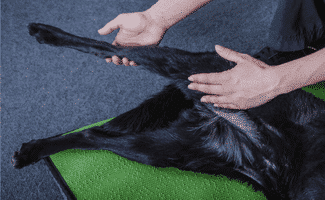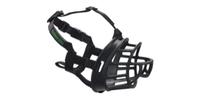
To keep the lights on, we receive affiliate commissions via some of our links. Our review process.

Has your dog started limping, but you don’t know why? Just like humans, dogs can begin limping for a wide variety of reasons. Although dog limping is pretty common, it’s still worrisome for pet parents because it means your pup is either injured or has an underlying health condition. We give you some tips on how to tell why your dog is limping, when to see your veterinarian, and how you can help your pup at home.
What To Do If Your Dog Is Limping
Contents
First, you’ll need to identify what type of limp your dog has. There are two types of limping in dogs: gradual onset and sudden onset. Gradual onset limping develops slowly over time and is usually a sign of a degenerative condition like arthritis or hip dysplasia (especially if your dog is limping on his back leg). A dog suddenly limping is typically due to an injury or trauma.
How Serious Is The Limp?

Next, you’ll need to assess how serious the limp is by watching your dog walk. Identify which leg is affected. Is your pup able to put most of his weight on the leg when walking, or is he stumbling on it? Does your dog limp when walking, but balance on the leg when standing still? Is your dog limping but not in pain? Is your dog limping after playing? Does the limping come and go?
With minor limps, dogs still use the leg but just won’t put all their weight on it. If your dog seems otherwise comfortable and not in pain, he may not need veterinary care. However, if the limping persists for more than 24 hours, you should call your vet.
If the limping is more severe, you’ll need to assess if you can wait to see your regular vet or if your pup needs emergency care. If your dog seems in serious pain and isn’t putting weight on the limb, it’s time for immediate care — he could have a broken bone or dislocated joint.
When To Seek Immediate Vet Care
If your dog exhibits any of the following symptoms, it’s time to see your vet immediately or go to an emergency vet clinic.
- Extreme pain (vocalizing, trembling, changes in behavior like aggression, anxiety, hiding, etc.)
- Dangling limb (dislocation)
- Obvious signs of a break or abnormally shaped limb
- Limb dragging
- Swelling
- Excessive bleeding
- Lethargy
- High fever
- Vomiting
Why Is My Dog Limping?
Many types of injuries and illnesses can cause limping and lameness in dogs. The cause may be obvious in some cases, but many limps require veterinarian attention to determine the cause.
General Causes

- Broken bone or dislocated joint
- Ligament sprain or muscle strain
- Paw injuries (embedded foreign object, insect sting, wound, broken toenail)
- Wound or sting on leg
- Nerve damage or spinal injury
- Infection (external or internal)
- Arthritis
- Invertebral disc disease
- Bone disease or cancer
- Inflammatory diseases
- Lyme disease
- Congenital abnormalities
Dog Limping On Front Leg
Some of the most common conditions that cause limping only on front legs include:
- Elbow dysplasia
- Shoulder injury
- Osteochondritis dissecans (OCD) of the shoulder joint (a joint disease)
- Injury or inflammation of the biceps
Dog Limping On Back Leg
Some of the most common conditions that cause limping only on back legs include:
- Cruciate injury
- Patellar luxation
- Hip dysplasia
- Achilles tendon tear
Veterinary Diagnosis & Treatment

Your vet likely will conduct a physical examination of your dog to determine the limb’s range of motion and level of pain. An x-ray may be required to identify broken bones or joint problems. Your vet may also perform other tests including a CT scan, an MRI, bloodwork, joint fluid analysis, or other lab tests. Treatment depends on the cause and can vary anywhere from rest or anti-inflammatory medication to surgery.
When Pet Insurance Can Help
If you have pet insurance for your dog and your vet recommends costly treatment for conditions like arthritis, hip dysplasia, cruciate injuries, etc., and the condition wasn’t pre-existing, your costs should be mostly covered. If you don’t have pet insurance but are curious to learn how it can help with major vet expenses, read our pet insurance guide to find out whether it might be a worthwhile investment for your family.
How To Treat A Limping Dog At Home
If you’ve determined that your dog’s limp doesn’t require emergency care, there are several things you can do to help figure out the cause and ease your pup’s discomfort.
Examine Your Dog’s Leg

First, examine your dog’s leg with the help of a family member or friend to keep your dog restrained. You may need to put a muzzle on your pup to keep him from biting. If your pup shows signs of pain or becomes agitated, don’t proceed — it’s probably best to have your vet assess the problem in case it’s more severe than you suspect.
- Look between the toes and on the pads for foreign objects (splinters, thorns, glass, etc.), punctures, sting sites, or toenail breaks. Most dogs will pull back their leg when you touch the sore spot. Look for any wounds on your dog’s leg.
- Applying gentle pressure, work your hand along the inside and outside of your pup’s leg. Feel for any signs of swelling, heat, abnormal bumps, and discomfort when you touch a certain spot.
- You’ll also want to bend and flex the leg joints to see if there’s any tenderness or resistance from your pup.
The following video shows you how to carefully examine your limping dog. Make sure to be as gentle as possible.
First-Aid For Limping
If you’ve examined your dog and don’t find any obvious need for emergency care, here are some of the ways you can help him at home.
Wounds, Foreign Objects & Broken Nails

- If you find a minor wound, first control the bleeding, then gently clean it with soap and water and apply antibacterial ointment (it’s best to check with your vet about any ointment you plan to use to be on the safe side).
- For a foreign object in your pup’s pads or toes, carefully remove it if possible and follow the same instructions above for wound care.
- If your pup has a broken nail, control the bleeding with a towel and apply styptic powder or corn starch on the nail to help stop the bleeding. Carefully remove any dangling or splintered part of the nail. If the damage is severe, it’s best to have your vet remove it.
Mild Swelling & Stings/Bites
- For mild swelling or bruising on any part of your dog’s leg, it’s always a good idea to call your vet to see what they recommend. If it’s a minor muscle sprain, you can apply an ice pack to the area for 15 minutes twice per day.
- Insect stings or bites usually cause mild swelling and redness. Apply a thick paste of baking soda and water to the site to soothe pain and apply an ice pack for at least 10 minutes to help with swelling. Monitor your pup carefully for any signs of distress — some dogs are allergic to bee stings, and this is an emergency.
Rest & Confinement
Make sure you limit your dog’s activity if he’s limping. Don’t take your pup on walks until the limping clears up, and don’t allow him to jump up on furniture or walk up or down stairs. You may need to confine your pup to his crate for rest, especially if you won’t be home. Again, if your dog’s limping persists for more than 24 hours or worsens during this time, get veterinary attention.
Does My Dog Have Arthritis?
The most common cause of slowly progressing limping in dogs is osteoarthritis. In fact, this degenerative joint disease affects one in five dogs as they age. If you’ve noticed your dog limping slightly or having decreased mobility issues, make an appointment with your vet. Treatment for arthritis depends on the severity of the disease and could include prescription medication, joint supplements, physical therapy, or surgery.
Tagged With: Orthopedic

